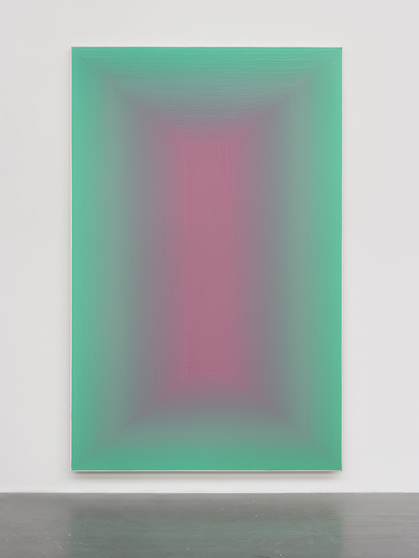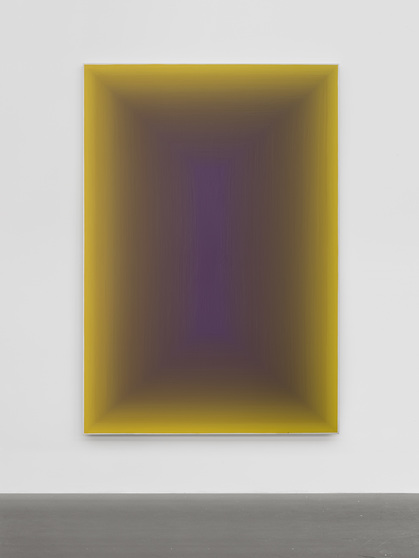
R
E
V N
E
X
T
Wang Guangle may be known for his colorful abstractions on canvas, but the element most fundamental to the Beijing-based artist’s work is time. A Fujianese burial tradition, in which an elderly person purchases a casket and adds a coat of lacquer every year until they finally pass, served as the inspiration for his “Coffin Paint” series (2004– ), where Wang paints layers of color to re-enact this commemoration of longevity, mortality and time.
A labor-intensive process similarly went into the making of his 2018 solo exhibition, “Duo Color,” at Pace Gallery, New York. The 14 paintings, completed in a year, likewise required layers of acrylic to achieve the gradations of contrasting colors. Each work produces a three-dimensional illusion, as if the viewer were staring into a passageway. The dimension not immediately apparent is a temporal one. Only up close and at certain angles, catching the surface’s gleam under the light, can one discern the artist’s meticulous application of paint and begin to contemplate that which cannot be seen.
In many of your older paintings, you’ve either focused on a single color or multiple layers of color, as seen in “Coffin Paint.” What inspired you to highlight two opposing colors in “Duo Color”?
The “Coffin Paint” series and the current series are all based on layers of colors; the repetitive and slow gradation and changing of colors. In my paintings, the color itself is not of primary importance; I can use many colors, or I can use no color. It’s not the main focus of my practice.
My working method is like this: here is a bucket of red paint, and a bucket of green paint. The first layer is all red. Then for the second layer, I add a little bit of green into the red bucket and mix it, just like stirring coffee. But the second layer is slightly narrower to leave the pure red edges. When it is dry, I add a little bit of green again and add on another layer. Eventually, the content in the red bucket is replaced by green paint. There’s a gradual move toward the center. The color itself is not that important; the most important thing is the repetitive pattern of the whole process.
The notion of “color” refers to a Buddhist concept used to capture the appearance of the material world. Can you explain the physicality of your painting process and its connection to spirituality?
In Buddhism, especially in China, we call the real world chenshi, which literally means “dust world.” We usually use the term hongchen, “red dust,” to refer to this mortal world. You can see that there is a long tradition in China of using color terms to describe reality. For me, the process of dealing with colors is how I deal with the real world.
The repetitive labor could be considered a daily practice for cultivating the spiritual realm. In a well-known Buddhist story, someone asks a Zen master, “What shall I do to learn Buddha-dharma?” And the Zen master said, “Just sweep the floor.” Everyone can learn the abstruse Dharma by simply sweeping the floor; maybe after thousands of times of sweeping the floor, you would come to understand something. What I am trying to do is to rethink daily practice in contemporary life with this concept. Furthermore, my process is about how mechanical and repetitive labor can have its own meaning spiritually.
Historically, Fujian, where you’re from, has a lot of religious diversity, including Christianity, Catholicism and Taoism. Did your upbringing influence your own spiritual beliefs or your work in any way?
It’s true that Fujian province is very diverse in terms of having different religious practices, including Islam. It was something I only realized later, though, because my hometown is on the edge of the whole area, so it’s not affected that much by Christianity. But Buddhism and Taoism definitely have had a large influence on me. My mom practices Buddhism but not in a very strict way. All these things influenced me in a subtle way.
When I was young, I didn’t like religion as I thought it was feudal and unenlightened. There was a process for me to become aware of the diversity in Fujian—this is also on a cultural level. I experienced a change in attitude toward Buddhism when I realized my mom had been practicing Buddhism for a long time. She has this really cool demeanor. The troubles and worries in this “dust world”—she deals with things in a very composed way. After her conversion to Buddhism, she wouldn’t limit her mind to a particular place. So my mom has this nature where she can handle her surroundings perfectly. She has this strong sense of calm. That’s something I admire a lot.
Time is an important factor in your work. How long did it take you to complete each of these new works? Do you plan out ahead of time how long it will take?
It’s sort of casual. Sometimes, I will only paint one layer in one day. Sometimes, it depends on the drying process of the paint. If I can move on to the second layer, I will, but otherwise I just leave it. So maybe a piece will take two to three months to finish. I don’t plan what specific amount of time I need. I only design the process, like the method of mixing the paint.
You’ve previously said that your paintings “don’t show any action.” All the action—the labor that goes into each work—is invisible. Is your intention that although the time and labor that go into each piece may not be immediately apparent, they are things that someone viewing the work might think more carefully about?
The invisibility is something I had a mind because that’s my understanding of painting. I feel that painting should be the traces and markings of action rather than the action itself. So the action itself is not invisible—the viewer could probably trace backwards from the markings on the painting to restore what kind of brushstrokes had been applied to the canvas. My intention is not for my paintings to be considered special. For this series, the application of each layer of paint isn’t special. It’s just like what a house painter would do. Everyone could do it if they wanted.
I want painting to be very ordinary because I feel, in that way, the abstraction could be more universal. Lots of people can access it not because the technique requires skill; rather, it’s the whole process. To me, there’s not a big difference between a painter and a street cleaner. And in that way, if you reduce the expectation toward the technique and the specialty of a painting, you would feel the temporality of the painting more. You could feel time manifesting itself.
At the Central Academy of Fine Art in Beijing, you studied traditional oil painting. What was the shift from painting more narrative subjects to something purely abstract?
When I first started to learn oil painting, it was a shock for me to see how different it is from the brushstrokes in Chinese calligraphy and traditional painting. In Chinese traditional painting, you use ink and rely on lots of gestural movement. And if it’s not good, you would probably abandon the whole sheet and move on to a new one. But for oil painting, you actually work on the same thing again and again. If we consider Impressionism, how you feel and how you depict a vivid thing, you would actually depict them in colors and hues and sometimes thoughts. If I see a glass of water, I consider it as a convergence of different paints and colors, rather than the thing itself. So that’s how my perspective changed. I realized that physical things aren’t as important as the way I paint.
When I first started oil painting, it was in the Western tradition from the Renaissance until Impressionism. And then I realized that I could paint in a photorealistic way. But, to use the example of the glass of water, I realized that the more I approached the image of the glass, the farther away from the essence of that image I was getting. Because the way we perceive is based on scientific facts and concepts, but how you consider the glass of water actually depends largely on our human and cultural definitions—what is the glass, what are the bubbles in it? It’s also related to Kant’s theories and materiality. So it seems like a sharp transition from figurative to abstract painting, but how we see is really subjective, and subjectivity leads to abstraction. For me, it’s not that different painting realistically or abstractly.
Is that why artist Song Dong described your work as “realistic abstraction”? How would you define that term? Would you say that it continues to apply?
Song Dong’s description is very accurate. There aren’t many critics in China that could come up with a better description. It seems very paradoxical that the two words could be combined together. But as I said before about the contrast between subjectivity and objectivity, maybe abstraction and realism can be combined together. And then because the main theme in my practice is time, that adds another dimension. Time itself is already an abstract concept.
As Chinese contemporary art becomes increasingly visible around the world, how do you see your work in dialogue with global currents?
The whole context of Chinese contemporary art is in reference to Western art because Chinese contemporary art is a reflection of Westernization. But in my opinion, culture cannot be global. Maybe capitalism can be, and maybe techniques can be, but definitely not culture. The issue I care about the most is the issue of modernization of traditional Chinese culture, and how it can make some developments of its own.
Traditional forms and shapes do not easily manifest themselves in the context of modern and contemporary culture. So what I want to do is to make them perceptible. I want to shape tradition in a way that can be sensed by us today. I’m not offering something brand new. I’m just working on the traditional concepts and ideologies that we used to have.
Where do you think your practice might lead?
I’m working on a new series, but it would be a bit hard to describe it formally. The concept is focused on time. There’s a metaphor that I really like regarding art history. The classic works from each era are like the snake of art shedding its skins. Like a snake will evolve, and the skins will look like lots of layers left over. It will shed its skin of the classic works we see and remember today. So for me, every series, every creation is about finding a perfect new skin for the idea and the concept I have in mind. And it has to distinguish itself from the previous one.
The artist’s job is to reveal the snake, to create a skin for it. Every era is like this. I don’t think art history is advancing; it’s merely changing its clothes. Art is always there.
Mimi Wong is a New York desk editor of ArtAsiaPacific.
The author wishes to thank Qianfan Gu and Hansi Liao for their help with translation.
This interview has been edited for length and clarity.
Wang Guangle’s solo exhibition “Duo Color” is on view at Pace Gallery, New York, until February 9, 2019.
To read more of ArtAsiaPacific’s articles, visit our Digital Library.


















